Everything about having a lawn is great:
Hacks you use to improve its look and increase its yield,
Equipment you utilize for those hacks,
Species of flowers and plants you grow in it.
But not everyone can own a lawn or yard.
That’s when houseplants come into play and what better of a houseplant than Peperomia!
So, here’s a complete “Peperomia Plant Guide” with growing instructions, species, issues, and why you should have it in your homes.
Table of Contents
What is peperomia?

This genus pf plant has been around for decades.
Peperomia gets its name from close resemblance to the black pepper plant.
It is a genus of compact houseplants with thick, fleshy leaves and juicy stems. They belong to the pepper family.
Commonly referred to as rubber plants (although they both are different), these are low-maintenance houseplants, can grow in a small area, and have more than 1000 species.
People looking to brighten up their houses with greenery can grow these ornamental plants easily. They come in many colors:
- Green
- Red
- Silver
- Purple
Although some species of peperomia plant can grow up to 2 feet, they are generally short-heightened plants and grow to a max height of 1 foot.
Some trail downwards as vines while others grow vertically upwards or spread sideways and the general spread of these plants is around 8-14 inches.
Below are the general properties of these plants.
| Family | Piperaceae |
| Normal height | 1 foot |
| Leaves | Different shapes, 1-4 inches in size |
| Flowers | Grow in the form of spikes |
| Ingestible | No (not harmful to pets) |
You can make any corner of your house vibrant with these plants. There are innumerable species; some can grow perfectly by the window, some in shady spots, while others in terrariums.
Before we discuss the growing instructions and types of Peperomia you can grow indoors, let’s see why you should have it in your house.
Why It Is The Perfect Houseplants For You?
- It can be grown easily without any strict considerations. No special soil, sunlight or water requirements are needed.
Because the fleshy stems and leaves can retain water, they can survive against droughts or even when you forget watering them even for a week.
- Different species have different foliages which can be grown in combinations for creating a pleasing focal point in the house.

We strongly believe there should be plants inside your house as they are psychologically proven to be beneficial. You can make a blend of small and large Peperomia with different sizes of pots.
- Unlike other large houseplants like Rhaphidophora, Money Plant, Bird of Paradise and Majesty Palm, it doesn’t grow or spread that much so it is also suitable for small parts of the house.

You don’t have to specifically decide for a corner in the lounge for this houseplant. It can go on your side tables, your corner stands, or your windows.
- Because they are smaller in size, so they can be repotted easily in case you want to upgrade them to a colored container or pot.
- They are non-toxic to your pet cats and dogs which also makes it one of the safest houseplants for you. These pets love to nibble at different plants and the luxury of being unharmful is no less than a blessing.
- They are readily available in the market in all price ranges, so you need not worry even if you are low on cash.
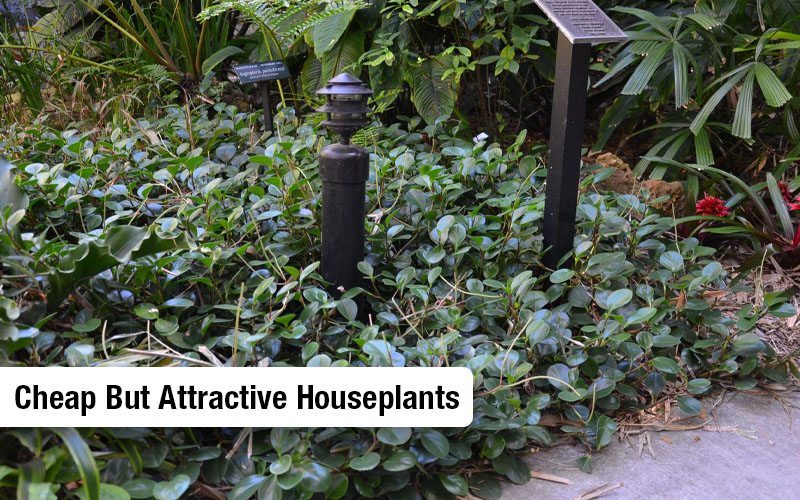
Potted varieties are available for as low as $5 to $25.
- They don’t require special pesticides to keep harmful insects away always. Even household items would suffice (will be discussed below)
Peperomia Care | How To Grow it?
Although it is a low-maintenance plant that doesn’t mean it can grow in every sort of a situation.
Here are the basic guidelines you should keep in mind while growing them.
1. Water requirement

They don’t need frequent watering; once or twice a week is fine.
And don’t overwater it as well because it would lead to root rot. The soil 1-2” beneath the top layer should be dry.
The type of the season shouldn’t be the notifying factor for you to water the plant, rather it should be the dryness of the soil.
Peperomia leaves often wilt or turn yellow because of being overwatered and that tends to happen a lot, especially if there are kids taking care of it: they are just too kind.
2. Light

Medium and indirect light is needed by Peperomia plants. An ideal location for them is east or west-facing window but any spot receiving the morning light is just fine.
They can do well in artificial light or shady conditions too but that would lighten the bright green foliage. Also, they can tend to get branched in order to reach sufficient light which disturbs their compact demeanor.
You can easily prune them if they grow that way and then alter their location.
3. Soil Needs

Soil that is loose and chunky is your best bet. As the roots need plenty of oxygen so mixing the soil with perlite or gravel is recommended.
This increases the drainage of the soil and lets air be distributed evenly through it. You should also have a base plate beneath the pot for drainage.
Slightly acidic soils with pH 5-6 have been seen to produce much healthier leaves and stems.
4. Temperature and Humidity
As they are tropical in nature so warm and humid conditions are more appreciated. Anything in the range of 60-80oF is ideal while temperatures below 30-40oF are not advised.
That being said, there is a misconception that Peperomia plants can’t survive in low-humid areas.
However, their thick leaves, very suitably, can allow them to tolerate low humidity levels as well.
5. Fertilizing
Almost all species of Peperomia can survive without being treated with fertilizer throughout their life; another indication of them being low-maintenance.
In fact, It is not the lack of fertilizer but excess water and shortage of light that results in curling leaves discolored foliage, and stunted growth.
However, you can feed them with an all-purpose houseplant fertilizer every 3-4 months if the chosen potting soil has poor drainage or the plant is showing signs of unhappiness.
Peperomia varieties | Which species to grow as a houseplant?
We mentioned in the start that it has over 1000 species but there are some which are ideal as houseplants: easy to grow, not very pricey and readily available.
Variegated Peperomia
Variegated refers to a leaf configuration in which there are different color zones other than green. In this case, they are colors like yellow, grey, silver and dark green.
1. Watermelon peperomia

Seldom would you meet people calling it with its scientific name: Peperomia argyreia because the “watermelon” title is just so suitable.
This mini plant gets the name because of its foliage having an almost exact resemblance with the outer skin of a watermelon: light green leaves with dark green or silver stripes running vertically in a curved manner.
Each leaf is held by a single stalk which is red in color and non-woody in nature.
As peperomia is all about variegated and green foliage thus it would be uncool to talk about flowers here (spiked green flowers can grow in summers on this plant)
| Water | Once a week |
| Soil | 2 part peat and 1 part perlite is a great composition for a potted version |
| Light | Beside an east-facing window as it needs bright but indirect light |
| Size | 6-9 inches |
| Problems | Leaves darken if there is not enough light |
2. Peperomia prostrata

Widely known as “String of Turtles”, Peperomia Prostrata is widely grown by people inside their houses. It looks ravishing when hanging in a basket or planter.
Why basket?
Because they are cascading plants and can grow as vines till 1 foot. They are ideal hanging houseplants for kid’s rooms, offices and bedrooms.
The shades of the leaves can vary from light green to yellow and dark green with a combination of small and large leaves. Generally, as the leaves grow towards the end of the vine, they tend to shrink in size.
| Water | Keep the plant generally moist in summers, let the soil dry before watering in winters |
| Soil | Well-drained soil with a topping of worm casting |
| Light | Indirect light as most Peperomias |
| Size | 6-12 inches |
| Problems | Overwatering can cause protrusions on the leaves |
3. Peperomia puteolata

The dark green foliage of this plant features grey stripes and is commonly known as the “Radiator plant” or “Chinese money plant”.
Unlike watermelon peperomia, a single stalk can bear many leaves and is red or maroon in color; non-woody and fleshy.
It can be potted and kept on wooden shelves with other houseplants or Peperomia variants.
| Water | Once a week, occasional deep watering a month |
| Soil | Well-drained and chunky soil |
| Light | Indirect light |
| Size | 8-16 inches |
| Problems | Direct sunlight causes scorching of leaves |
Green Peperomia
These types of peperomia have solid green-colored foliage.
4. Peperomia obtussfolia
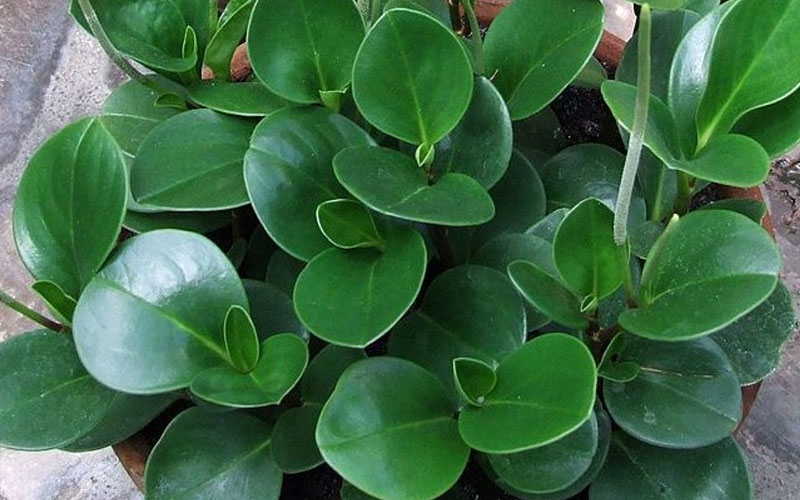
Commonly known as the baby rubber plant, it has dark green leaves which are oval in shape and succulent in texture. Some varieties have red edges around the leaves.
It originates from South America where it grows under the trees to obtain its nutrients from the fallen leaves and dead fruits. Thick stems, tall white legs in the spring and a bushy stature are its distinctions.
| Water | Once a week but don’t overwater it |
| Soil | Well-drained; potting soil with peat moss and some sand |
| Light | Medium. Would die in direct sunlight |
| Size | 15-30 inches |
| Problems | Wilting due to overwatering |
5. Peperomia polybotrya

Nature has given us such ravishing gifts that we can’t ever thank it fully.
Heart-shaped leaves of this plant is another of that lot. They are native to Peru, dark green in color and contain a fascinating sparkle. They can grow both in a compact form and scattered form.
| Water | Water after the soil has dried completely |
| Soil | It needs to be highly well-drained so the pot should essentially have a drainage hole |
| Light | Bright and indirect. The direct light of winter sun is harmless |
| Size | 8-15 inches |
| Problems | Mealybugs. Treat with neem oil spray if you see yellow spots on the leaves |
6. Peperomia rotundifolia
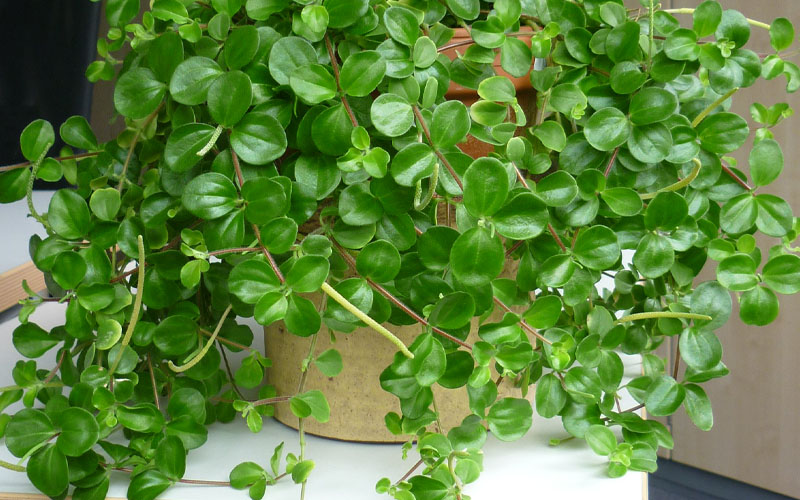
Round and succulent leaves that can grow either upwards or in a trailing pattern is what defines this type.
If you have the trailing species, grow it in a hanging basket otherwise in a pot. It grows round leaves, some bigger and some smaller to create a “cute” combination.
| Water | Water once a week |
| Soil | Well-drained soil |
| Light | Partially shaded areas of well-lit rooms |
| Size | 1 foot max |
| Problems | Overwatering |
Other colors of Peperomia
These species include solid colors of foliage, other than green and can be exuberantly paired with green and variegated peperomia plants.
7. Peperomia caperata

And here’s when things turn vibrant. This variant is known as ripple peperomia as well because of deep grooves on the leaves which makes it highly attractive and unique. But that’s not it.
It has dark green, silver frost or dark red colored leaves which enhances the beauty and thrill even more. Red stalks with red leaves on them look extremely pleasing to the eye.
They are dwarf plants and one of the most grown Peperomias. You can grow them in pots or Groot containers.
| Water | Water after the top soil has dried completely |
| Soil | Well-aerated soil |
| Light | Place in a shady spot of a room which receives daylight |
| Size | 20cm max |
| Problems | Overwatering can cause root rot |
8. Peperomia Rosso

We had it confusing to either include it in the variegated section or colored section and finally we opted for the latter.
On the upper side, it has a dark green color with green (or silver) and rippled veins and on the underside, bright red color. Even to much pleasure, the leaves have their top bent upwards which provides the viewer with a hint of the red hue.
Just like the watermelon peperomia, it is a uniquely colored houseplant and deserves to be kept inside the house.
| Water | Water every 7-10 days |
| Soil | Half perlite and half peat moss with some gravel. Can also grow outdoors as a ground cover |
| Light | Bright and indirect |
| Size | 8-10 inches max |
| Problems | Overwatering can cause root rot |
Peperomia propagation: How to regrow new peperomias
Imagine you have one plant each of the 8 species mentioned above.
We bet you would want more because that’s how brilliant they are!
You can propagate peperomias through two methods
- Stem cuttings
- Leaf cuttings
You need to consider the weather, method of propagation, soil mixture and right parts to choose in order to make this process successful.
Always carry out propagation in summer or spring because that is when the plant is fully growing.
Then opt for the more suitable method; if you are propagating variegated peperomia, go for the stem cutting method, choose a rooting mix with half perlite and half peat moss and finally, choose the most healthy and developed parts of the plant.
1. Propagating by stem cuttings
i. Choose two to three healthy stem cuttings and cut them at a point that bears 4,5 fully developed leaves.
ii. Remove the lower leaves, including the petioles.
iii. Secure the stem cuttings in separate foam caps or neoprene caps by constructing a hole in them.
iv. Dip the cuttings in hormone rooting powder.
v. Examine the cuttings after 3,4 days to see for signs of root appearing.
vi. After 7-10 days, when you observe the appearance of roots, transfer them into the potting mixture by digging holes and ensuring the roots are fully buried.
vii. Water the soil and secure the cuttings.
viii. Because peperomia love humidity, cover the cuttings with plastic bags having holes in them and put them in a spot having a temperature of 60o-70o
ix. Lift the bags for an hour each day to improve the passage of air.
x. Within a week, signs of new growth will begin appearing.
xi. Let it grow for a week or two and then transfer it to the main growing pot.
2. Propagating by leaf cuttings
i. Propagation with leaf cuttings is not that different.
ii. Take two, three separate leaves and steady them in a bottle cap or neoprene cap by forming a cut in them.
iii. Dip them in the rooting powder. It would take longer for leaf cuttings to prepare roots than stem cuttings.
iv. When you observe four to five shoots appearing from the leaf stem, only then transfer them to the potting mixture.
v. Water the soil fully so that there is a layer of unabsorbed water.
vi. Cover the leaves with plastic bags as you would do with the stem cuttings.
vii. It is not necessary that all cuttings will develop roots.
viii. The ones that do, carefully transfer them to the main growing pot after 3,4 weeks.
Problems & Diseases in the Peperomia Plant
We can’t leave you relaxed by simply saying that these are easy-to-grow plants that require little care.
There are still many problems and issues associated with these rubber plants. And we will leave no stones unturned to notify you of them.
1. Psychological issues
i. Droopy leaves

Limp leaves, like every other houseplant, become a source of alarm for the residents, especially if small plants like Peperomia are hung inside the living room or bedroom where they are easily noticeable.
The reason is underwatering. We mentioned that these plants only need watering once a week but if you oversee this privilege and let the top 2-3” of the soil dry for more time, leaves will start to droop.
Another solution to this problem is to soak-water it:
Place the pot in a tub of water or basin and let the plant absorb water from below. Keep it in this situation for 45 minutes and insert a finger in the soil to feel the moistness.
ii. Leaves turning yellow

The most common cause of this condition is overwatering. If you have kids that are too sympathetic towards the plant or you yourself are being too kind to water it every next day, be prepared to face the music!
Pests like spider mites and mealybugs could be the second reason. They can hide under the leaves and suck the moisture of the succulent leaves and cause it to turn yellow.
You should spray botanical insecticides or neem oil to treat such leaves.
iii. Curling leaves

Leaf curling is usually due to calcium deficiency in the soil. If the soil is acidic or you are overwatering the plant, calcium deficiency would occur.
You can also apply 20 20 20 fertilizer (equal proportions of nitrogen, phosphorus and potassium) to prevent the plant from absorbing excessive calcium and thus countering the shortage in the soil.
iv. Uneven growth pattern
We can’t stress it enough that:
And overwatering is the biggest cause of root rot. Plants would show uneven growth rates with few leaves growing bigger and healthier than the rest.
Another reason of this ambiguity can be excessive use of fertilizers. You should only fertilize the soil if you sense slow growth or some expert recommends you to. The addition of fertilizers every two months or so is not advised.
2. Insect related issues
i. Mealybugs
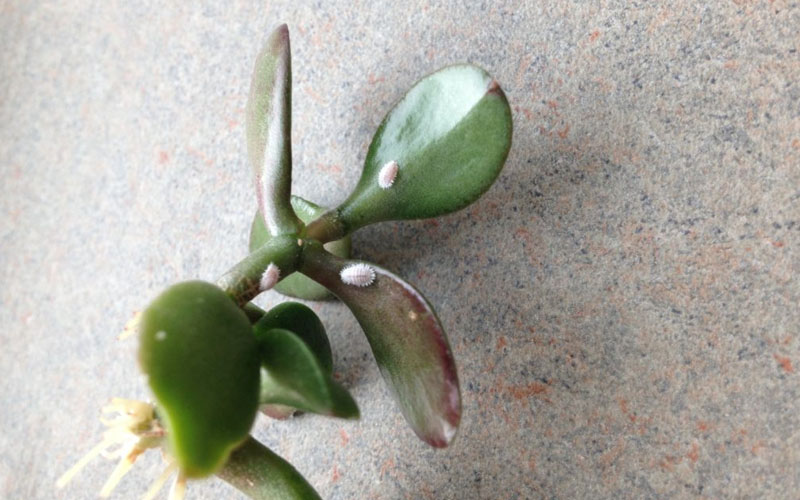
They appear as white masses on the veins of the leaves and can slow down the growth process. If left untreated for long, the plant may wilt and die.
Recommended treatment is an insecticide or general-purpose pesticide spray on both sides of the leaves.
ii. Thrips

Thrips are small insects with colors of white, brown, and green. They have slender bodies and can be identified with hair extensions around their bodies. Their infestation causes leaves to curl and distort in shape.
In order to get rid of them, the insecticidal spray is preferred. If you want something more powerful, mix neem oil with it.
iii. Mites

Mites are arthropods and can go unnoticed until the damage is severe. Indications of mite attacks (spider mites specially in case of peperomias) are yellowing of leaves, serrated margins, and brittleness in them.
Spray insecticidal soap or pesticide on the plant to kill these harmful insects.
iv. Worms
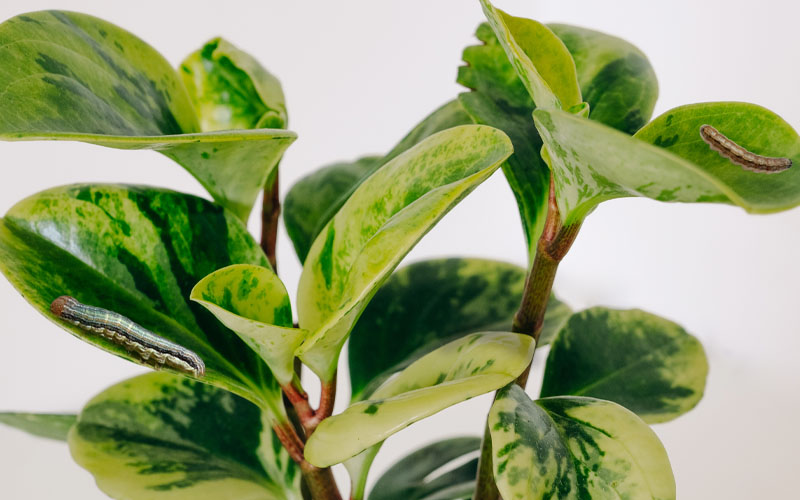
If you notice holes in the leaves, it is quite evidently the doing of worms. They are discoverable so you can simply discard them off by picking them but that’s not always possible.
So, you can spray neem oil, vinegar solution (2 tablespoons of vinegar in 4 liters of water) or a mixture of organic soap mixed with warm water.
3. Fungal & viral diseases
i. Phyllosticita leaf spot
Brown or black spots can appear on these plants, especially the watermelon peperomia, where they appear on the leaf margins.
Such leaves should be given quick attention because this is a fungal disease and can spread throughout the plant if not treated. Remove the affected leaves from the plant along with their petioles.
ii. Pythium
Two indications should alarm you of Pythium rot:
For younger plants, black rot starts to appear between the petiole and the stem.
For older plants, blackness appears on the stem at the soil level.
In this disease, the roots are blackened and die eventually. To avoid it, always use new pots and potting mixture for planting species. When you see blackness on the leaves, separate them from the plant to avoid transmission to other parts.
iii. Cercospora leaf spot
Protruded brown to black spots appear on both surfaces of the leaves but normally the undersides. If the condition prolongs, the leaves can stunt and disfigure.
To stay away from this fungal condition, always take healthy plants from the nursery and use new, sterilized soil. Peperomia obtussfolia is most susceptible to this disease.
iv. Ring Spot
Plants diseased with Ring spot have translucent spots appearing in the start which slowly propagate to brown color and thin lines that disfigures the leaves.
The area of the leaf affected by this disease will have a lighter color than the healthy part. If there are some spots and lines, they would appear as brown and not disturb the shape of the leaf but if they are too many, they will.
There is no treatment for this condition; you have to remove the infected leaves and parts of the plant.
Yes, however, before buying, you should make sure that the plant is healthy and pest-free.
How To Buy Peperomias

When you are buying these houseplants, the following considerations should be quite clear in your mind:
- It should be free of any diseases or other harmful conditions like yellow leaves, black spots, mealybug attacks, or wilting.
- Buy from a reputable breeder, nursery, or online platform. Although stores like eBay, Amazon, and Etsy sell high-quality Peperomia plants it is always advised to purchase from nurseries.
- These green houseplants cannot survive low temperatures so buy from a nursery that has kept them in warm and humid conditions.
There is every chance that the damage to the plant have been done but is not visible in the plant parts at the time of purchase.
Concluding lines
So this is it from our side. Now it’s your turn. Share the blog with your friends who are looking for easy-to-care houseplants and comment your respective experiences with your Peperomias below.
Don’t forget to check our other gardening articles.

